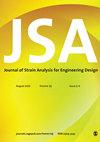Influence of the contact with friction on the deformation behavior of advanced high strength steels in the Nakajima test
IF 1.8
4区 工程技术
Q3 ENGINEERING, MECHANICAL
Journal of Strain Analysis for Engineering Design
Pub Date : 2021-05-27
DOI:10.1177/03093247211021257
引用次数: 6
Abstract
This work presents a new understanding on the deformation mechanics involved in the Nakajima test, which is commonly used to determine the forming limit curve of sheet metals, and is focused on the interaction between the friction conditions and the deformation behaviour of a dual phase steel. The methodology is based on the finite element analysis of the Nakajima test, considering different values of the classic Coulomb friction coefficient, including a pressure-dependent model. The validity of the finite element model is examined through a comparison with experimental data. The results show that friction affects the location and strain path of the necking point by changing the strain rate distribution in the specimen. The strain localization alters the contact status from slip to stick at a portion of the contact area from the pole to the necking zone. This leads to the sharp increase of the strain rate at the necking point, as the punch rises further. The influence of the pressure-dependent friction coefficient on the deformation behaviour is very small, due to the uniform distribution of the contact pressure in the Nakajima test. Moreover, the low contact pressure range attained cannot properly replicate real contact condition in sheet metal forming processes of advanced high strength steels.中岛试验中接触与摩擦对高级高强钢变形行为的影响
这项工作提出了对中岛试验中涉及的变形力学的新理解,该试验通常用于确定金属板的成形极限曲线,并侧重于摩擦条件与双相钢变形行为之间的相互作用。该方法基于中岛试验的有限元分析,考虑了经典库仑摩擦系数的不同值,包括压力依赖模型。通过与实验数据的对比,验证了有限元模型的有效性。结果表明:摩擦通过改变试样内的应变率分布来影响缩颈点的位置和应变路径;应变局部化使接触状态在从极部到颈部的部分接触区域由滑移变为粘着。这导致在颈点应变率急剧增加,随着冲头进一步上升。在中岛试验中,由于接触压力分布均匀,压力依赖摩擦系数对变形行为的影响很小。此外,所获得的低接触压力范围不能很好地模拟先进高强钢板料成形过程中的实际接触情况。
本文章由计算机程序翻译,如有差异,请以英文原文为准。
求助全文
约1分钟内获得全文
求助全文
来源期刊

Journal of Strain Analysis for Engineering Design
工程技术-材料科学:表征与测试
CiteScore
3.50
自引率
6.20%
发文量
25
审稿时长
>12 weeks
期刊介绍:
The Journal of Strain Analysis for Engineering Design provides a forum for work relating to the measurement and analysis of strain that is appropriate to engineering design and practice.
"Since launching in 1965, The Journal of Strain Analysis has been a collegiate effort, dedicated to providing exemplary service to our authors. We welcome contributions related to analytical, experimental, and numerical techniques for the analysis and/or measurement of stress and/or strain, or studies of relevant material properties and failure modes. Our international Editorial Board contains experts in all of these fields and is keen to encourage papers on novel techniques and innovative applications." Professor Eann Patterson - University of Liverpool, UK
This journal is a member of the Committee on Publication Ethics (COPE).
 求助内容:
求助内容: 应助结果提醒方式:
应助结果提醒方式:


